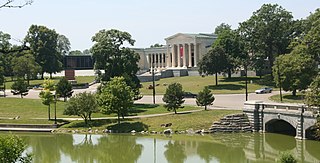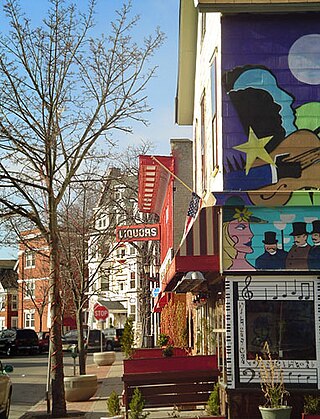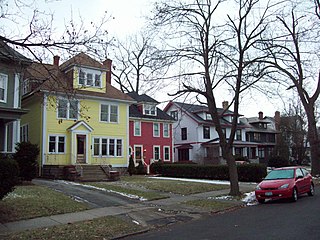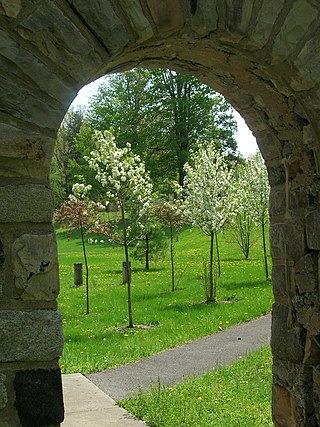
Frederick Law Olmsted was an American landscape architect, journalist, social critic, and public administrator. He is considered to be the father of landscape architecture in the United States. Olmsted was famous for co-designing many well-known urban parks with his partner Calvert Vaux. Olmsted and Vaux's first project was New York's Central Park, which led to many other urban park designs, including Prospect Park in Brooklyn and Cadwalader Park in Trenton, New Jersey. He headed the preeminent landscape architecture and planning consultancy of late 19th century United States, which was carried on and expanded by his sons, Frederick Jr. and John C., under the name Olmsted Brothers.

A parkway is a landscaped thoroughfare. The term is particularly used for a roadway in a park or connecting to a park from which trucks and other heavy vehicles are excluded.
A National Parkway is a designation for a protected area in the United States given to scenic roadways with a protected corridor of surrounding parkland. National Parkways often connect cultural or historic sites. The U.S. National Park Service manages the parkways.

The Emerald Necklace consists of a 1,100-acre chain of parks linked by parkways and waterways in Boston and Brookline, Massachusetts. It was designed by landscape architect Frederick Law Olmsted, and gets its name from the way the planned chain appears to hang from the "neck" of the Boston peninsula. In 1989, the Emerald Necklace was designated as a Boston Landmark by the Boston Landmarks Commission.

Frederick Law Olmsted National Historic Site is a United States National Historic Site located in Brookline, Massachusetts, a suburb of Boston. Frederick Law Olmsted (1822–1903) is recognized as the founder of American landscape architecture and the nation's foremost parkmaker of the 19th century. In 1883, Olmsted moved his home to suburban Boston and established "Fairsted", the world's first full-scale professional office for the practice of landscape design. Over the course of the next century, his sons and successors expanded and perpetuated Olmsted's design ideals, philosophy, and influence.

New York State Route 198 (NY 198) is a state highway located entirely within the city of Buffalo, New York, in the United States. It is named the Scajaquada Expressway for Scajaquada Creek, which it covers as it heads across northern Buffalo. NY 198 connects the Niagara Thruway in the Black Rock neighborhood to the Kensington Expressway (NY 33) on Buffalo's east side, dividing the city's premier public park in half.
Humboldt Park may refer to:

Delaware Park–Front Park System is a historic park system and national historic district in the northern and western sections of Buffalo in Erie County, New York. The park system was designed by Frederick Law Olmsted and Calvert Vaux and developed between 1868 and 1876.

The Allentown district is a neighborhood in Buffalo, New York. The neighborhood is home to the Allentown Historic District.

Many of the public parks and parkways system of Buffalo, New York were originally designed by Frederick Law Olmsted and Calvert Vaux between 1868 and 1896. They were inspired in large part by the parkland, boulevards, and squares of Paris, France. They include the parks, parkways and circles within the Cazenovia Park–South Park System and Delaware Park–Front Park System, both listed on the National Register of Historic Places and maintained by the Buffalo Olmsted Parks Conservancy.

Fenway, commonly referred to as The Fenway, is a mostly one-way, one- to three-lane parkway that runs along the southern and eastern edges of the Back Bay Fens in the Fenway–Kenmore neighborhood of Boston, in the east-central part of the U.S. state of Massachusetts. As part of the Emerald Necklace park system mainly designed by Frederick Law Olmsted in the late 19th century, the Fenway, along with the Back Bay Fens and Park Drive, connects the Commonwealth Avenue Mall to the Riverway. For its entire length, the parkway travels along the Muddy River and is part of the Metropolitan Park System of Greater Boston. Like others in the park system, it is maintained by the Massachusetts Department of Conservation and Recreation.

Washington Park is a 372-acre (1.5 km2) park between Cottage Grove Avenue and Martin Luther King Drive, located at 5531 S. Martin Luther King Dr. in the Washington Park community area on the South Side of Chicago. It was named for President George Washington in 1880. Washington Park is the largest of four Chicago Park District parks named after persons surnamed Washington. Located in the park is the DuSable Museum of African American History. This park was the proposed site of the Olympic Stadium and the Olympic swimming venue for Chicago's bid to host the 2016 Summer Olympics. Washington Park was added to the National Register of Historic Places on August 20, 2004.

Riverside Park is a historic park located in the Riverside neighborhood in Buffalo, New York. Located in northwest Buffalo, it is an individual park designed by the Olmsted Architectural Firm in 1898 after Frederick Law Olmsted's retirement. It is on a 22-acre (8.9 ha) site on a bluff overlooking the Niagara River. Riverside Park was designed for active recreation and periodic alterations have occurred as the community's recreation needs have changed. Despite the changes, the park retains numerous original design elements and remains as the final element completed as a part of the Olmsted plan for Buffalo's park system.

Parkside East Historic District is a national historic district located at Buffalo in Erie County, New York. The district is architecturally and historically significant for its association with the 1876 Parks and Parkways Plan for the city of Buffalo developed by Frederick Law Olmsted. It consists of 1,769 contributing structures developed from 1876 to 1936, as a middle class residential neighborhood. The district largely contains single-family dwellings, built in a variety of popular architectural styles, and located along the irregular and curvilinear street pattern developed by Olmsted. The district is located to the east of Buffalo's Delaware Park and includes the Walter V. Davidson House and the separately listed Darwin D. Martin House, both designed by Frank Lloyd Wright.

Parkside West Historic District is a national historic district located at Buffalo in Erie County, New York. The district is architecturally and historically significant for its association with the 1876 Parks and Parkways Plan for the city of Buffalo developed by Frederick Law Olmsted in 1876. It consists of 137 contributing structures developed primarily from 1923 to 1940, as a middle class residential neighborhood. The district largely contains single-family dwellings, built in a variety of popular architectural styles, and located along the irregular and curvilinear street pattern developed by Olmsted. They include homes along Nottingham Terrace and Middlesex Road, and segments of Meadow Road, Lincoln Parkway, Delaware Avenue, and Amherst Street. The district is located to the north of Buffalo's Delaware Park.
Cazenovia Park–South Park System is a historic park system located in the South Buffalo neighborhood at Buffalo in Erie County, New York. The interconnected set of parkways and parks was designed by Frederick Law Olmsted as part of his parks plan for the city of Buffalo, as inspired in large part by the parkland, boulevards, and squares of Paris, France.

Rider–Hopkins Farm and Olmsted Camp is a historic farm and summer camp located at Sardinia in Erie County, New York. It consists of a 188.4-acre (0.762 km2) property containing a Greek Revival style brick farmhouse dating to the 1840s known as the James and Abigail Hopkins House. The property retains its original boundaries as purchased from the Holland Land Company in 1828. The property is also the site of the Olmsted Camp; a turn of the 20th century family summer camp in the Adirondack "Great Camp" tradition. The camp buildings are in the Arts and Crafts style and grounds are laid out in a naturalistic manner. The camp was designed by Harold LeRoy Olmsted (1886–1972); a locally prominent architect, landscape architect, and artist, who was also a distant relative of Frederick Law Olmsted.

Utica Parks and Parkway Historic District is a national historic district located at Utica in Oneida County, New York. It consists of four contributing historic elements: a historic right-of-way known as the Memorial Parkway and the three large parks it connects: Roscoe Conkling Park, F.T. Proctor Park, and T.R. Proctor Park. The district includes seven contributing buildings, three contributing sites, 26 contributing structures, and five contributing objects. The park and parkway system was designed between 1908 and 1914 by the firm of Olmsted Brothers Landscape Associates, headed by Frederick Law Olmsted Jr. The Utica Zoo is located in Roscoe Conkling Park.

The Architecture of Buffalo, New York, particularly the buildings constructed between the American Civil War and the Great Depression, is said to have created a new, distinctly American form of architecture and to have influenced design throughout the world.

The historic Chicago park and boulevard system is a ring of parks connected by wide, planted-median boulevards that winds through the north, west, and south sides of the City of Chicago. Neighborhoods along this historic stretch include, Logan Square, Humboldt Park, Garfield Park, Lawndale, Little Village, McKinley Park, Brighton Park, Gage Park, Englewood, Back of the Yards, and Bronzeville. It reaches as far west as Garfield Park and turns south east to Douglass Park. In the south, it reaches Washington Park and Jackson Park, including the Midway Plaisance, used for the 1893 World's Fair.




















